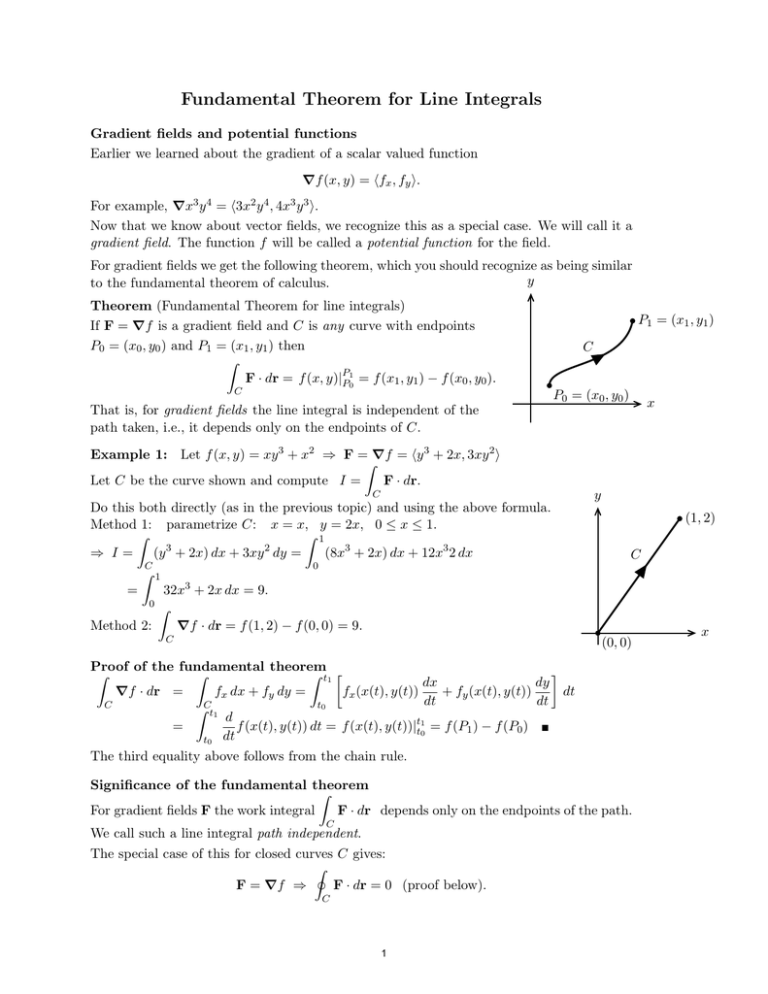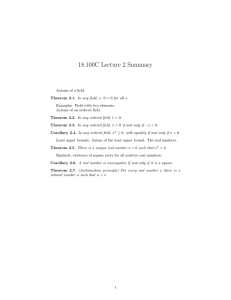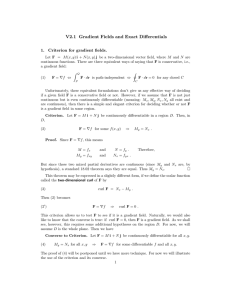Fundamental Theorem for Line Integrals
advertisement

Fundamental Theorem for Line Integrals Gradient fields and potential functions Earlier we learned about the gradient of a scalar valued function vf (x, y) = Ufx , fy ). For example, vx3 y 4 = U3x2 y 4 , 4x3 y 3 ). Now that we know about vector fields, we recognize this as a special case. We will call it a gradient field. The function f will be called a potential function for the field. For gradient fields we get the following theorem, which you should recognize as being similar y to the fundamental theorem of calculus. Theorem (Fundamental Theorem for line integrals) If F = vf is a gradient field and C is any curve with endpoints P0 = (x0 , y0 ) and P1 = (x1 , y1 ) then C P1 = (x1 , y1 ) C F · dr = f (x, y)|PP10 = f (x1 , y1 ) − f (x0 , y0 ). P0 = (x0 , y0 ) x That is, for gradient fields the line integral is independent of the path taken, i.e., it depends only on the endpoints of C. Example 1: Let f (x, y) = xy 3 + x2 ⇒ F = vf = Uy 3 + 2x, 3xy 2 ) F · dr. Let C be the curve shown and compute I = y C Do this both directly (as in the previous topic) and using the above formula. Method 1: parametrize C: x = x, y = 2x, 0 ≤ x ≤ 1. 1 ⇒ I = (y 3 + 2x) dx + 3xy 2 dy = (8x3 + 2x) dx + 12x3 2 dx C (1, 2) C 0 1 32x3 + 2x dx = 9. = 0 vf · dr = f (1, 2) − f (0, 0) = 9. Method 2: C (0, 0) Proof of the fundamental theorem dx dy fx (x(t), y(t)) + fy (x(t), y(t)) dt dt t1 vf · dr = C fx dx + fy dy = C t1 t0 dt d f (x(t), y(t)) dt = f (x(t), y(t))|tt10 = f (P1 ) − f (P0 ) dt t0 The third equality above follows from the chain rule. = Significance of the fundamental theorem F · dr depends only on the endpoints of the path. For gradient fields F the work integral C We call such a line integral path independent. The special case of this for closed curves C gives: F = vf ⇒ F · dr = 0 (proof below). C 1 x Following physics, where a conservative force does no work around a closed loop, we say F = vf is a conservative field. Example 1: If F is the electric field of an electric charge it is conservative. Example 2: The gravitational field of a mass is conservative. Differentials: Here we can use differentials to rephrase what we’ve done before. First recall: a) vf = fx i + fy j ⇒ vf · dr = fx dx + fy dy. Z b) vf · dr = f (P1 ) − f (p0 ). C Using differentials we have df = fx dx + fy dy. (This is the same as vf · dr.) We say M dx + N dy is an exact differential if M dx + N dy = df for some function f . Z Z As in (b) above we have M dx + N dy = df = f (P1 ) − f (P0 ). C C Proof that path independence is equivalent to conservative We show that Z F · dr is path independent for any curve C C is equivalent to I F · dr = 0 for any closed path. C This is not hard, it is really an exercise to demonstrate the logical structure of a proof showing equivalence. We have to show: i) Path independence ⇒ the line integral around any closed path is 0. ii) The line integral around all closed paths is 0 ⇒ path independence. i) Assume path independence and consider the closed path C shown in figure (i) below. Since I the starting point P0 is the same as the endpoint P1 we get F · dr = f (P1 ) − f (P0 ) = 0 C (this proves (i)). I ii) Assume F · dr = 0 for any closed curve. If C1 and C2 are both paths between P0 C and P1 (see fig. 2) then C1 − C2 is a closed path. So by hypothesis I Z Z Z Z F · dr = F · dr − F · dr = 0 ⇒ F · dr = C1 −C2 C1 C2 C1 That is the line integral is path independent, which proves (ii). y y P0 = P1 C1 C P1 C2 x Figure (i) P0 x Figure (ii) 2 F · dr. C2 MIT OpenCourseWare http://ocw.mit.edu 18.02SC Multivariable Calculus Fall 2010 For information about citing these materials or our Terms of Use, visit: http://ocw.mit.edu/terms.




